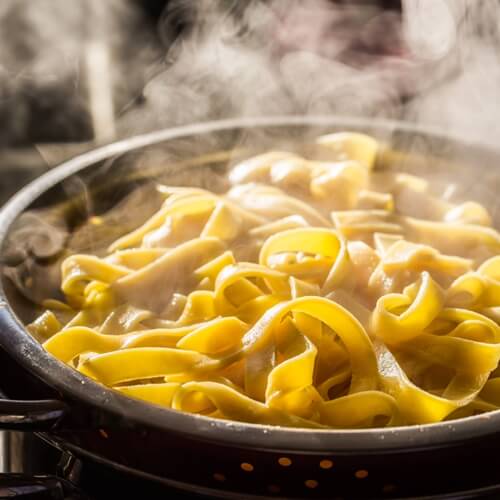Perfecting Your Pasta Pairings
To make an excellent pasta dish, your pasta and sauce needs to be a great match. Different pasta shapes are designed to compliment different sauces, and you should take this into account as you prepare dishes. International culinary schools teach students all over the world how to make their dishes by skillfully matching these different elements.
Although there are many different pasta shapes, there are some general qualities of pastas that make them good for one type of sauce or another. Here are some guidelines when matching pasta to sauces:
Long, flat
Example: Fettuccine
Long, flat pastas are sturdy, and can handle rich, thick sauces. Generally speaking, the weight of your sauce should be directly proportional to the width of your pasta. Wider pastas will be able to carry the weight of your heaviest sauces.
Long, tubular
Example: Bucatini
This shape is perfect for loose sauces that have lower viscosity. These sauces will be able to take advantage of the hollow center of the pastas and run through them. This pasta shape is a great way to bring extra flavor to every bite when using a thin sauce.
Long, thin
Example: Spaghetti
These noodles are best served with an olive-oil based sauce. Olive oil sticks to pasta, which will help the sauce coat the long, thin strands. If you’re adding vegetables to a dish with these types of noodles, cut them julienne. This will let them blend naturally into the dish.
Short, wide tubes
Example: Ziti
Hello, versatility: These types of pasta noodles can be used in nearly any dish. Soups, salads, meat or vegetable sauces all make sense with them. The wide tubes in the center of these pastas mean they can capture any kind of sauce.
Short, small tubes
Example: Macaroni
There’s a reason macaroni and cheese is a dish everyone’s heard of: Short pastas with thin tubes are the perfect match for cheese sauces. They work particularly well in baked dishes, where the cheese is able to liquefy and settle inside the pasta.
Shaped pastas
Example: Farfalle (bow ties)
Meat sauce is the best match for these whimsical pastas. This has to do with how the pasta’s shape is able to capture the pieces of meat. Because shaped pastas are full of ridges and folds, it’s easy for meat to get caught in the pieces of pasta.
Pasta making tips:
- Be aware of how much sauce you’re using. You want to have enough sauce that it coats the pasta, not covers it. You should never feel as if your pasta is swimming in sauce.
- Make sure your pasta is fully drained before adding the sauce. Any excess water will dilute your sauce’s flavor, and may prevent the sauce from being able to adhere to the pasta.
- Combine pasta and sauce right away: Don’t let your pasta cool before you mix. Always serve pasta hot: You can use heated bowls to keep it warm if you need to wait.


